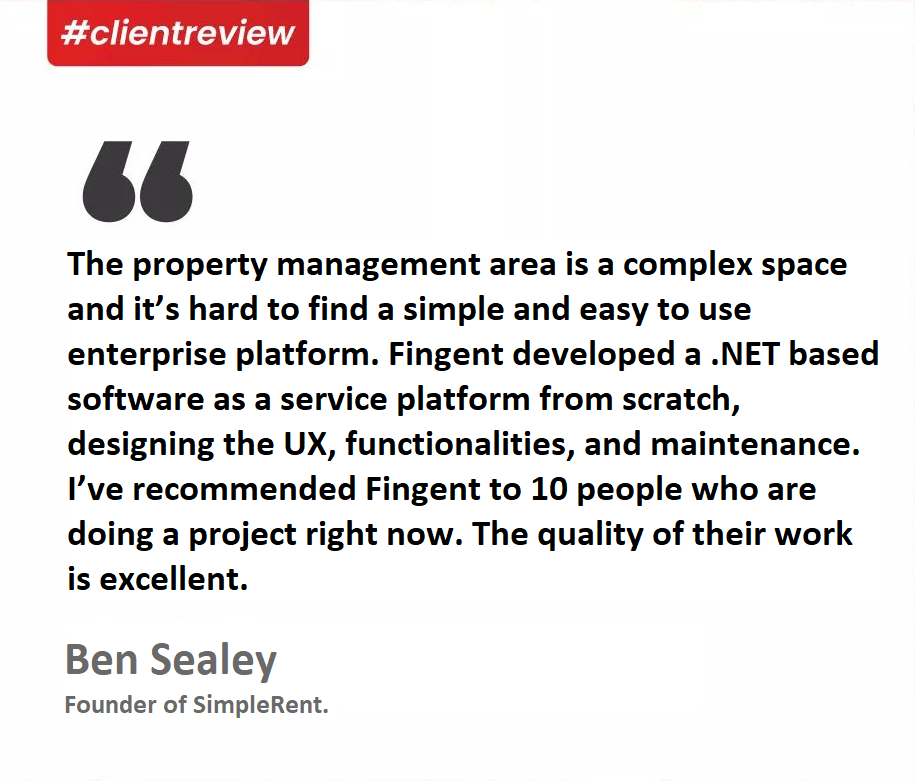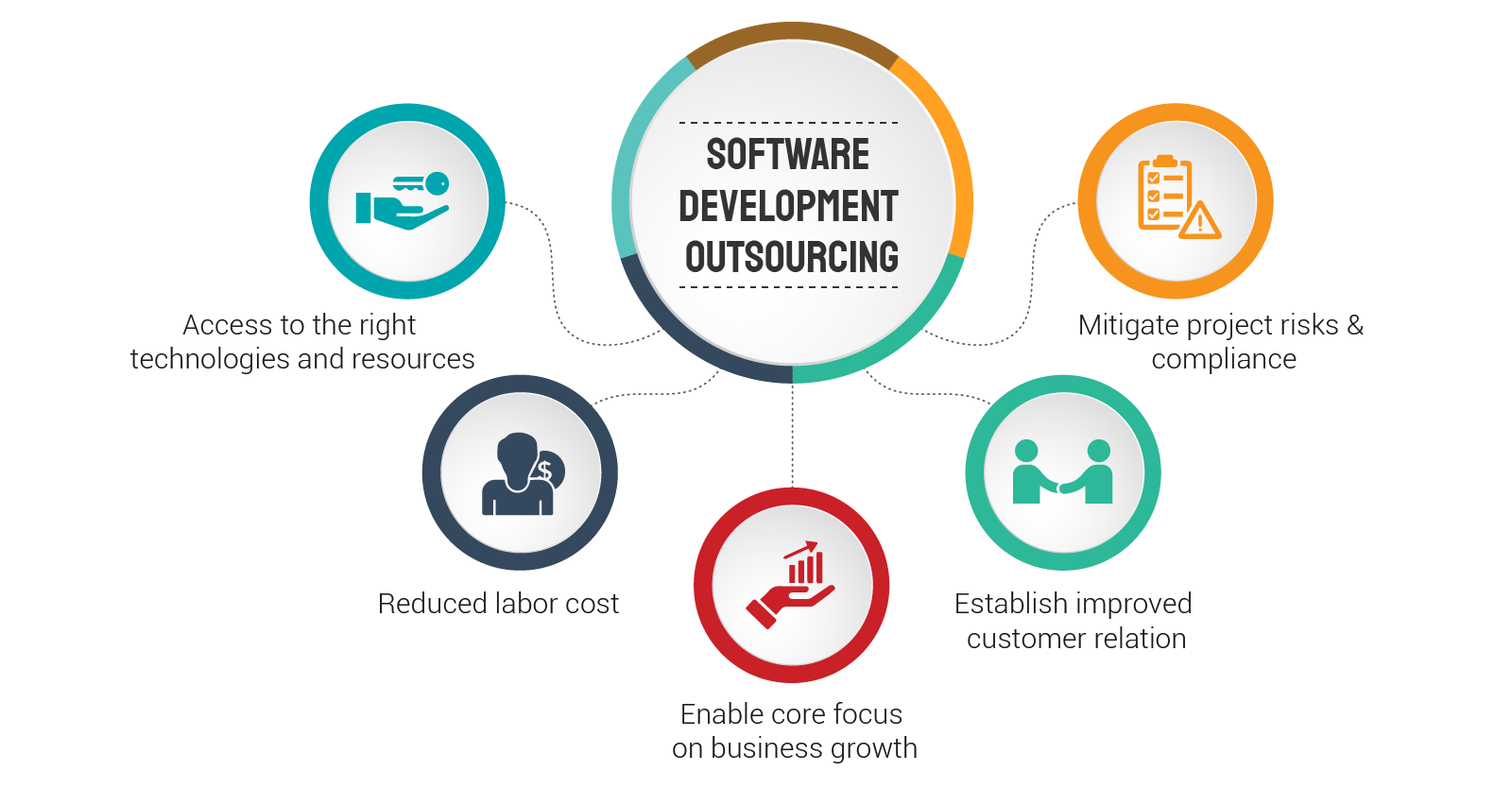Category: IT Infrastructure
All That You Need to Know about Managed Services for IT!
IT requirements evolve continually as the technology undergoes rapid changes. This has led to increased security threats to data and downtimes which can disarm any business. Before you panic however, let’s begin by saying that many companies have been able to successfully handle these challenges. The solution – a good partnership with the right managed IT services provider.
Managed services for IT play an integral role in the modern business field as it is nearly impossible to venture into contemporary services without some form of IT support. Managed IT services can help you smoothen different processes on the cloud while managing security and finance challenges efficiently in a continuous manner. That isn’t all. This article will help you see why managed services for IT is important and how you can implement it to improve your business operations.
Read more: What Is IT Consulting? How Can It Revitalize Your Business?
What do you mean by Managed Services for IT?
Managed services for IT are services that are outsourced to an external IT service provider. That service provider is completely responsible for the day-to-day operations of your specialized applications and business equipment. This allows your in-house IT team to focus on more strategic IT programs and frees up your team to focus on your business’s core competencies.
What is the importance of Managed Services for IT?
Traditionally, IT-related maintenance was done only through the “break-fix” methodology. This meant that a business would call a maintenance expert only when something broke down. This would completely halt all business operations until the problem is fixed. The more your system stays down, the more will be your organization’s money drain. Unresolved IT issues such as security breaches that compromise your data could prove to be costlier than you think. Such data security breaches are devastating for your business.
Thankfully, as the name suggests, Managed services for IT allows smooth management of a business without disrupting the flow of business operations. On your behalf, your IT service provider will manage, monitor, and resolve the problems of your IT systems and functions. Such a partnership allows you to focus on your core business process without any hindrance caused by IT issues.
Read more: Software Development Outsourcing – Why software development outsourcing is a smart move now?
The most important advantages of Managed IT Services
1. Get the expertise you need
New technology might bring in new problems that your IT team may not have the knowledge or experience to solve. Then there is the issue of management. Fortunately, both these problems can be resolved by your managed service provider. A key advantage of the managed service model is that it allows you to either hire an entire team of IT professionals or choose specialists depending on the demands of each project.
2. Cost-effective
Managed services for IT lowers labor costs. Also, it can completely eliminate the cost of hiring and training new IT staff. The best upside is that you won’t ever have to worry about unexpected service costs. This means your organization can now shift from a capital expense model to an operating expense model.
3. Scale your system as needed
Your technology decides whether you need to scale up or down. Managed IT service providers can respond to such changes in real-time.
4. Downtime reduction and recovery
Managed services for IT provide backup solutions to protect critical information. In the event of a disaster, they can also provide avenues for service continuations. For smaller businesses, this can be a lifesaver.
How can you leverage Managed IT Services to improve your business?
Leveraging managed services for IT cannot be done in a one-size-fits-all way because most companies use different options to meet their overall goal. Though the services offered by each provider may vary, they can still be useful when handled properly. There are businesses that use three or more types of IT functions. If yours is one of those businesses these tips below will help you take the most advantage of managed services.
1. Choose your provider wisely
Each business has its own specific requirements. Identifying that requirement will make it easier to choose the right managed services provider. Often, most businesses need a minimum of three IT services (eg: cloud, IT consulting, and data and network security). But you will need to assess your business needs and come to the exact number. Once you have your requirements down, you can go about researching the credentials of the IT partner. Previous clients and case studies is the best place to start. The best way to find a capable managed service provider is through referrals, work colleagues, and reviews on online platforms.
2. Develop a business relationship
The best collaboration is when your managed IT services provider partners with your existing IT team in a seamless way. With that in mind, it is important to build a good working relationship with your provider. This will ensure that your skills complement each other, and resources are effectively used leading to better business outcomes. It will also give your team the opportunity to learn as much as possible from them.
3. Device a reliable data backup and recovery strategy
The most important objective of hiring managed services for IT is to protect data. Your data is under tremendous risk during a virus attack, machine error, unexpected hacking, or improper handling. During such instances, it is critical to have a good back-up strategy. Such a strategy will ensure that your business does not grind to a halt due to lost data. Fortunately, hiring good managed services for IT makes it easier for your company to develop a strategy that can protect existing data and retrieve lost data.
Read more: Digital Innovation – 10 Services Offered by Fingent to Prepare Your Business for the Future of Digital Innovation
What does the future hold for Managed IT Services?
According to Gartner, 56% of business leaders engage with service providers for long-term development and maintenance. This will result in 63% of global managed service providers gaining their revenue through digital business infrastructure operations by 2023. Managed services for IT have kept the business world running and will continue to do so in the future. Are you keeping pace with it?
Survive and thrive
In our current state of extraordinary upheaval brought by the COVID-19 pandemic, managed services for IT may be your company’s greatest hope for surviving and thriving during and after these unprecedented times. Partner with us and see for yourself! First though, take a look at our case studies and feel free to check our credentials. We want you to be sure we are the right fit for you.
Stay up to date on what's new

Featured Blogs
Stay up to date on
what's new



Talk To Our Experts
Stay up to date on what's new

Featured Blogs
Stay up to date on
what's new



Talk To Our Experts
Why IT is the guardian angel of businesses during a recession?
- Introduction
- Advantages of cutting-edge IT solutions
- 9 practical examples of how IT solutions recession-proof your business
- Use the present crisis as an unprecedented opportunity to lead
Introduction
Decreased revenue churn and the uncertainty in the global economy is making it difficult for many businesses to keep their financial wheels turning during the COVID-19 slouch. They are forced to revisit their strategies w.r.t. how they manage and operate their business, and vital to this is re-visiting their use of technology.
IT solutions lead to new ways of innovation and this can help organizations make lasting improvements to recession-proof their business. IT solutions allow leaders to redesign processes from the ground up. IT automates processes, with data captured at the right moment to deliver insights on processes and how to streamline them. IT innovative solutions rewire organizations to perform better through a fundamental reboot of how work gets done.
This article presents
- How businesses are adopting IT solutions to improve productivity and cut costs, while they recession-proof their business.
- 9 practical examples of IT solutions.
Advantages of cutting-edge IT solutions
– Improve productivity
Lack of technology has been one of the reasons why employees are unable to reach their productivity targets. According to a recent Workers’ Experience Survey, 85% of employees said they would prefer their organizations to provide them with the entire IT ecosystem (including tested and supported devices, accessories, and so on) that will help them to be more productive in their work.
– Cut costs
Most businesses are understandably reluctant to loosen the strings of their purse in the current situation of uncertainty. However, done in the right way, IT innovative solutions can be self-sustaining, and each of the incremental improvements will pay for the next leg of the journey. Take cloud computing for example. Cloud computing allows you to get rid of the hardware cost. Instead of purchasing your own equipment, the provider can offer you all that you need to keep your business running. Since it works on a per-per-use pricing model, it saves you from paying for any unused software/ hardware. 47% of IT executives report that their IT costs have dropped by 30-50% after they started using cloud infrastructure and apps.
– Recession-proof business
Technology will help you ensure that your business not only survives the imminent recession but also thrives. Among the many things, IT solutions will help you gauge customer engagement in real-time, keep your data clean to maximize new business growth potential, free up more time for employees to sell, and manage client experience.
Read more: Recession-proof Your Business with Digital Alternatives, Go Paperless!
9 practical examples of how IT solutions recession-proof your business
1. Cybersecurity
Data privacy continues to be a major cause of concern as incidents of phishing and other threats are on the rise. Businesses must rely on new and innovative IT technologies to help them differentiate and ensure growth in the evolving marketplace. Businesses that lack effective security measures face the ever-looming risk of exposing themselves to data theft that would result in breaking the trust of their stakeholders, customers, and the marketplace. Now is the time for a new take on protecting your organization.
Read more: Safeguarding IT Infrastructure From Cyber Attacks – Best Practices
2. Contactless shopping
The COVID-19 led safety norms such as social distancing have pushed businesses to use technology to lower interaction between people, products, and infrastructure. Contactless shopping allows your customers to conduct entire transactions on their mobile devices without touching anything else. For those who prefer stepping out to shop, technology solutions can be integrated and implemented for contactless shopping.
Read more: How Retailers Can Revive Sales While Adhering To Social Distancing Norms
3. Omnichannel for retailers
Innovative technology ensures that retailers have an omnichannel presence across all touchpoints. This means that they can go beyond brick-and-mortar locations to mobile browsing, social media, online marketplaces, and every online channel where the customer is inclined to browse. It helps retailers manage their tasks effortlessly while allowing customer engagement through a common quality service across various sales channels.
Read more: 6 Hot Technologies that Handhold Businesses Amid COVID-19 Impact
4. E-commerce
E-commerce solutions enable centralized management of all the orders as well as the inventory of both the digital and brick-and-mortar stores. This technology can direct the order placed online to the nearest store for faster delivery providing enhanced customer satisfaction. Automatic updates of the inventory ensure better stock management across all the stores. It further assists in automatic stock replenishment.
View Infographic: The Truth About E-Commerce, 2017-2020
5. Self-checkout systems
Secure cash handling machines and automated self-service checkouts are a huge success for retailers. Though initially it was used to reduce cost and for security reasons, now it has proved helpful in limiting staff contact with cash that is touched by other people, an essential technology in the current scenario.
6. Digital payments
For businesses that do not have access to expensive, automated machines, contact with cash can be limited by digital payments for in-store transactions. Low-value payments can be made contactless with just a ‘tap.’
Read more: Trends Shaping Mobile Payments Market Worldwide
7. Virtual trial rooms
Retailers can use several options available for customers who would like to see and experience the product before they make a purchase. Magic Mirror is one of those trends. it helps customers see what they would look like in different clothing styles by responding to their hand gestures and voice commands.
8. Chatbots
Based on machine learning, chatbots copy human conversations and react to written or spoken requests to deliver a service. Chatbots provide extensive customer assistance while your customers are shopping online. It allows you to provide customer support 24/7 leading to greater customer satisfaction. It keeps your customers engaged with interactive communication. Chatbots ensure that the buyer’s journey continues uninterrupted in the right direction. Since they are automated IT solutions, they allow your organization to handle several customers at the same time.
Read more: Capitalizing on AI Chatbots Will Redefine Your Business: Here’s How
9. Robotics in logistics
Use of Robotics in your logistics will ensure that you accomplish the same amount of work with improved efficiency and less cost. Businesses need workforce capability while they adapt to changing environments. COVID-19 has forced a large number of the world’s working population to go on extended periods of sick leave which has resulted in an increased need for workers. However, robotics could eliminate such concerns as these technologies become more widely used, becoming increasingly affordable and available. It has the potential to create a limitless workforce that does not claim retirement benefits, paid time-off, and other additional aspects of costs associated with human workers.
International Finance Corporation reports that logistics companies (including 3PL players) have increasingly turned towards robotics and automation for surviving the coronavirus crisis.
Read more: How Robotics in Logistics Helps Improve Supply Chain Efficiency
Use the present crisis as an unprecedented opportunity to lead
As the world is increasingly moving toward newer technologies, the expectations of consumers are also rapidly changing. The present scenario with the pandemic is further accelerating existing trends that push products and services towards emerging technologies. Organizations must be led by this change in behavior and meet their customers where they are. The current pandemic is a serious wake-up call for all businesses to recession-proof their business and mitigate the risk from such adverse conditions. Pick the right technology to propel your business growth. Partner with us top custom software development company and allow us to get you there!
Stay up to date on what's new

Featured Blogs
Stay up to date on
what's new



Talk To Our Experts
Why Does Your Business Need IT Consulting Services?
IT departments or on-site IT professionals have become increasingly significant for many types of organizations- small and large, today. As the COVID-19 pandemic has changed the way people work, giving rise to alternative workplace strategies, businesses are forced to rethink IT technology and strategy to keep up with the ‘new normal’. Companies, therefore, expect their IT budgets to grow.
So what’s IT consulting in simple terms?
Gartner defines IT consulting as “advisory services that help clients assess different technology strategies and in doing so, align their technology strategies with their business or process strategies.”
IT consultants are needed for software implementations, training, and maintenance. Some companies try to do these activities on their own. Many have succeeded in getting their software up and running to what they think is “Best Practices” for their company. However, with a technology consulting company like Fingent, you’ll rest assured that you’re dealing with someone who knows the product end-to-end. You’ll get to collaborate with an expert who knows how to look for alternatives or add-on solutions for that product. Thus, you end up streamlining the entire process of conversion, training, and implementation with an IT consultant.
Read more: Software Development Outsourcing – Why software development outsourcing is a smart move now?
Why should you hire IT consultants?
1. Flexible staff: Most IT consultants offer their services on a contract basis. Organizations may need to supplement their team for a holiday season; they may be rolling out new software or merging companies. There are a lot of situations where a company needs a lot more people for a small amount of time. They don’t have to hire full-time salaried people and then lay them off. Consultants can come in for a short time and do the job for them.
2. Proven expertise: Your organization may be the best in your LOB. But you may not have the required know-how in house, to implement the best IT solution for your business. Well-experienced IT consultants can advise the best modus operandi to ensure that your new IT project runs smoothly. A reputable IT consultancy would also bring in the shared knowledge of its many business partners. So, you’ll be at the receiving end of the latest trends and updates of the IT industry.
3. Outsider perspective: You are a part of your company. So, you may not spot the blunders that an outsider can quickly point out. Since IT consultants have already worked on similar projects before, they can quickly identify what would work and what would not. They can also bring in different schemes that can help improve ROI that may not have been visible to you.
4. Train employees: Employees are an asset to your company. So you have to provide them with the necessary training facilities to develop their skills and keep them engaged. IT consultants are always at the top of their game, making them good trainers. Suppose you have implemented a new ERP system. After understanding the needs of your company, IT consultants can provide customized training programs to your staff and equip them towards a smooth transition.
Read more: Digital Transformation Consulting Services – How digital transformation solutions redefine businesses with effective digital experiences
Business benefits of hiring IT consultants
1. Reduced Costs: Hiring in-house staff solely for your IT technical needs or training your existing employees are other options that you can consider instead of hiring IT consultants. While hiring new employees, you’ll have to include the added costs along with their salaries, including taxes, benefits, and overhead expenses. On the other hand, for training existing employees, you’ll have to shell out on a trainer and the skill acquired may not even be used in the future. Hiring IT consultants will help reduce downtime. Often, you bring in consultants to address a specific issue for a short period. Therefore, they prove to be more budget-friendly.
2. Better Security: Cyberattacks continue to derail large and small businesses alike. Consultants who specialize in IT security can help tackle and prevent these risks. After analyzing the risk points in your system, IT security consultants can advise on the best security practices that would suit your company. IT consultants can help prevent possible risks by implementing regular updates on your software, training employees to identify malware, developing appropriate disaster recovery solutions, and so on.
3. Focus on core business: SMEs generally fall into the trap of trying to save money by doing everything themselves. The companies whose core competencies lie in non-IT related industries have observed that finding solutions for IT problems zaps them of their time and energy. Not to mention the rise in frustration levels of your workforce as they spend hours doing what they’re not good at in the first place. Once you outsource your IT needs to a specialist, you’ll see speedy execution with higher efficiency in completing the project. Thus, investing in an IT consultancy will lead to better ROI.
4. Increased productivity and efficiency: IT consulting experts can help businesses optimize their systems. They can help homogenize your IT infrastructure according to the industry best practices. The resultant consistency can help streamline processes, create resilience, and reduce costs related to IT support. Next, as mentioned earlier, IT consultants help manage tasks like software updates, data, and network security that would otherwise be monotonous for your employees, enabling them to focus on increasing profits. Many enterprises are moving to the cloud to reduce their infrastructure costs associated with outdated physical servers. An IT consulting partner can help you realize the full benefits of the cloud by integrating all existing systems, making a smooth transition securely, and avoiding common mistakes.
Read more: Digital Innovation – 10 Services Offered by Fingent to Prepare Your Business for the Future of Digital Innovation
As technology grows by leaps and bounds, organizations have to find ways to grow along with the growth in business. The right IT consulting firm can help you use technology as a tool to increase productivity and reduce unwanted expenses. Need help to manage your IT needs? Fingent’s round-the-clock and customer-centric IT consulting services are bound to give you a competitive edge. We’re just a phone call away! Contact us now!
Stay up to date on what's new

Featured Blogs
Stay up to date on
what's new



Talk To Our Experts
How SAP Solutions Help with Business Continuity Challenges
Every organization needs a business continuity plan to carry out its critical business as usual, especially when the area where it operates is affected by a crisis like COVID-19. That’s where enterprise resource and business planning suites like SAP comes to your rescue. SAP solutions are designed to help you meet your business continuity goals and ensure that your establishment survives and recovers from a disaster efficiently.
“SAP Help Portal describes business continuity as the efforts to ensure that critical business functions will be continuously available for clients, customers, suppliers, and other entities.”
Business continuity planning, however, is not free of challenges. Varying business requirements can shoot up your investment costs. Consider scenarios such as the installation and maintenance of hardware, software, and data center infrastructure. A simple and cost-effective way to address these requirements will be to use efficient cloud computing solutions instead of massive physical servers. This is where SAP solutions can come handy. SAP Cloud Platform, SAP S/4HANA, SAP Cloud Analytics, SAP Leonardo, SAP Cloud Platform Internet of Things, etc. are only a few of the key services offered by SAP.
How SAP Solutions Help with Business Continuity Challenges
SAP is an efficient technological framework that can be easily incorporated into your existing business structure to maximize the productivity of your business functions. This helps boost the overall growth of your establishment.
SAP offers impressive ways to manage your clients, customers, and business interactions. With the right SAP solutions, you can fast-track and automate your routine processes and dedicate your skilled workforce to attend the core functions. Minimal workforce retention and lower equipment maintenance costs are two of the key benefits of deploying SAP into your business.
Related Reading: What is Business Process Expertise in SAP and Why You Need it
You will gain a high degree of flexibility by integrating SAP in your business structure. This way, you can adjust to the existing as well as imminent changes in the industry smoothly. That helps your establishment to adapt and evolve as per the varying market trends. By storing massive amounts of data on the cloud, you can also significantly reduce the operational and management costs of your business.
Business continuity plans can be very complicated to employ and execute. Traditional ways of managing the recovery infrastructure and testing the solutions can be very challenging and time-consuming. With reliable SAP solutions, all that can be managed flawlessly.
Below are some examples of how SAP solutions can help to solve different business continuity challenges.
Identifying Alternative Sources of Supply
Maintaining the supply chain is one of the most critical aspects to ensure efficient business continuity. Using SAP Ariba allows you to create smart connections with your suppliers so that you can communicate and collaborate with them adequately. The spend management solutions of SAP Ariba also ensure that your business is responsive and responsible, no matter what the crisis is.
SAP Ariba solutions help simplify the procurement and supply chain processes. It enables you to find new sources of supply for better management of your resources in the event of a disaster. At the same time, you can find profitable customers too, and scale your client relationships for superior sales cycles and cash control.
Financial Modeling and Managing Cash Flow
Financial modeling is key to make certain that your business continuity plans are authoritative and adequate. With the help of SAP S/4HANA Finance solution, you can easily manage your financial planning and accounting jobs. The ERP system also allows you to use real-time operational data and end-to-end planning for avoiding redundancy and time lags.
SAP S/4HANA Finance solution also supports accounts payable and receivable, so that you can keep an eye on the cash flow as well as create ad hoc simulations to see new business models or organizational changes. The treasury and financial risk management solutions of the ERP system allow you to integrate cash flow analysis and business planning, including the liquidity planning lifecycle. This is highly beneficial for effective accounts management.
Related Reading: SAP S/4HANA: Redefining End-to-End Solution
Employee Training and Certifications
Staff involvement is another vital element of a successful business continuity plan. However, holding a meeting to train and educate your staff members on the essentials of the business continuity and disaster management plans may not be possible always. This is where SAP SuccessFactors Learning Management System (LMS) emerges as a productive alternative. The online learning solution can simplify the process and adequately instruct your employees about the business continuity plan.
SAP SuccessFactors LMS can make sure that everyone is on the same page through proper training and emphasis on critical business functions. You can create easy-to-understand content for your employees and incorporate personalized and innovative elements to help them get a clear idea of the business continuity plan. You can also manage certifications and documents easily using the LMS software.
Download Our Case Study: Check out how Fingent automated integration between SAP SuccessFactors and SAP S/4HANA.
With a robust business continuity plan laid out using the right SAP solutions, you can have all the critical business data secured and accessible. This helps you recover from the disaster quickly and manage important business functions without affecting your customers or business reputation.
Fingent helps enterprises to frame robust business continuity plans leveraging SAP, S/4, and intelligent enterprise platforms. Our team includes members who are part of SAP’s core engineering team, who can provide consulting, advisory, implementation, integration, support, and monitoring services to ensure business continuity. Get in touch with us to learn more about our services.
Stay up to date on what's new

Featured Blogs
Stay up to date on
what's new



Talk To Our Experts
Today’s organizations require flexible ERP solutions for capturing new growth opportunities and embracing new business processes and models that allow them to reap the benefits of digital transformation. Faster adoption of intelligent technologies has become the new norm as organizations have increasingly started to look at their business from an integrated “end-to-end” perspective.
The end-to-end implementation helps ensure efficiency in terms of cost, performance, compliance, and insights through which process owners can improve the quality of service and speed up the execution time. Companies can become more agile, make faster acquisitions, meet high-level business objectives, and streamline processes by implementing the end-to-end process. It enables businesses to visualize duplicate efforts and eliminate them quickly.
Related Reading: Unlock the Potential of Intelligent Enterprise with SAP Leonardo
This article discusses how SAP S/4HANA can transform your end-to-end business process for enhanced efficiency.
What is an end-to-end business process?
An end-to-end business process is a process that is capable of addressing all your business requirements and processes in one centralized hub. It is a complete process cycle including all its various phases like project kick-off meeting, gap analysis, blueprint, realization, finalization, go-live, and after support.
In simple terms, the end-to-end business process starts with a customer’s request and ends with the successful fulfillment of that request. For businesses such as trading or manufacturing, end-to-end software has tools that can manage eCommerce, process orders, control stock, and manage warehouse and accounts.
It provides businesses with all the necessary components while managing the installation, integration, and maintenance of the process. The end-to-end process ensures that a business enterprise gets everything they need to function effectively. It can help minimize software costs as well as operational costs.
How S/4HANA transforms the end-to-end business process?
Since its launch in February 2017, SAP S/4HANA has been used extensively to provide “next-generation intelligent ERP”, enabling businesses to achieve digital transformation. With its three pillars, digital assistant, machine learning, and predictive analytics, S/4 is all set to transform the end-to-end business process.
Here are some ways how S/4 can transform end-to-end business processes:
1. Automation with intelligence
The ever-changing business infrastructure requires integrated, mission-critical, end-to-end processes. The intelligent ERP in the S/4 cloud caters to that very need. By further automating the process, it allows businesses to become more intelligent and agile. S/4 end-to-end processes are designed to work without interruption, thus improving agility. Since the cloud uses real-time embedded analytics, the processes function intelligently and automatically with nominal user input.
2. A game-changer
As the next-generation business suite, S/4 is designed to redefine how enterprise software creates value across industries with real-time insight. It also personalizes the user experience regardless of the device in use and eliminates batch processing by running end-to-end business processes at unprecedented speeds. The icing on the cake is that it can connect to IoT, Big Data, business, and social networks in real-time to create endless possibilities.
3. S/4 enables digitization
SAP S/4HANA is a business suite designed to help enterprises run uncomplicated end-to-end processes in today’s digital and networked world. Since S/4 can be deployed in the cloud or on-premise, it can drive instant value across lines of business with ultimate simplicity. It provides a guided configuration with the goals and value-realization plans for digitization activities that are part of the end-to-end implementation.
Related Reading: Create Intelligent Organizations with SAP Model Company
4. One system
With S/4 in place, employees do not have to spend time learning multiple systems. This ensures that the end-to-end process can be up and running as soon as possible. It minimizes disruption and results in a faster return.
5. Competitive edge
The source-to-pay solution is a decisive end-to-end process, which can improve the performance of an organization. This strategy covers the entire process starting from spend management through to accounts payable. By integrating SAP S/4HANA into source-to-pay, businesses can make better-informed decisions that translate into positive business impact and greater efficiency and productivity. Thus, streamlined source-to-pay processes give a competitive edge to businesses by helping them make intelligent procurement decisions.
Transform your business with S/4 for enhanced efficiency
Managing the end-to-end process can be challenging, but SAP S/4HANA can help businesses to stay ahead of the game by helping their customers to gain the most value through such interconnected processes.
By implementing S/4, businesses can experience greater automation to drive accuracy, efficiency, and better streamlined end-to-end processes. It can not only reduce time spent and risk of human errors but can also enhance data security. SAP S/4HANA can integrate strategy, process, procedures and policies, people, and technology into one cohesive effort ensuring that the organization is process-driven.
As discussed earlier, SAP S/4HANA is key to integrating end-to-end solutions into your business. To find tips on how you can seamlessly transition to SAP S/4HANA, click here.
Take the next step towards revolutionizing your business by getting in touch with us. Fingent, the leading custom software development company, and let’s make your business thrive with the power of this innovative solution.
Stay up to date on what's new

Featured Blogs
Stay up to date on
what's new



Talk To Our Experts
What are preconfigured solutions?
SAP Preconfigured solutions are implementations featuring standard functionality or common patterns. Since they include common enterprise features such as supply chain, finance, and inventory management, preconfigured solutions can be deployed rapidly. In simple terms, SAP preconfigured solutions are simple, ready-to-consume solutions that adapt to your business needs.
SAP Rapid Deployment Solutions allows the development of preconfigured solutions for specific functional areas, complete with pre-built reports, preconfigured content, and predefined best practices. Such suites enable enterprises to deploy software easily, with accelerated implementation times, and predictability in cost and scope.
Each preconfigured solution is a complete, end-to-end implementation. Enterprises may adopt it as such, or use it as a base for developing a full-blown customized solution. Open source solutions allow enterprises to download the source code and customize the solution.
Traditional preconfigured solutions came on-premise. The SAP HANA Enterprise Cloud heralds the cloud version of preconfigured solutions.
Related Reading: What is Business Process Expertise in SAP and Why You Need it
How preconfigured solutions enhance industry operations?
Preconfigured solutions spare enterprises from “rediscovering the wheel.” When solutions exist for standard requirements, it avoids the wastage in development efforts. Preconfigured solutions save time, trial-and-error, and labor. The in-built accelerators allow rapid implementation and configuration. The shortened time to market delivers a competitive advantage to firms.
A preconfigured solution offers a working model with glitches removed. These solutions connect key functional areas, to streamline operations and improve communication flow across departments. It automates routine and repetitive functions and offers well-structured content that improves visibility into key fields.
SAP offers built-in support for industry best practices. Solutions developed using SAP combines the latest technology, industry best practices, and processes in a single package.
Developers using SAP to build preconfigured solutions can adopt a modular and scalable approach. They mix modules to create targeted solutions such as CRM, field management suite, ERP and more. Clients may choose the most relevant reporting tools for their reports using SAP Business Intelligence Adoption rapid-deployment solution. SAP Predictive Analytics Content Adoption rapid-deployment solution helps to implement a predefined predictive analysis use case.
Transforming various industry verticals
Preconfigured solutions deliver efficiency improvements in several industries and verticals. Five of them are mentioned below:
1. Real Estate
Unstandardized information, inefficient processes, and weak communications often affect the real estate industry. Preconfigured solutions enable enterprises to streamline data and workflows.
Developing preconfigured solutions for key functional areas of the real estate industry allows business owners to access information in real-time, prevent opportunities from slipping through the cracks, and remain in control of the business. Here are a few key functional areas where pre-configured solutions can come to the rescue of real estate enterprises:
- Document management with powerful search and sort functionality.
- Process automation functions to streamline operations.
- Contact maintenance to keep track of customers and upcoming tasks.
- Reporting and analytics to generate and share data and other critical information.
2. Supply Chain and Logistics
Preconfigured solutions make the complex supply chain relationships simple and easy to handle. SAP’s Model Company for supply chain planning offers a ready-to-run, comprehensive solution, complete with relevant business content, accelerators, and enablement services.
The suite co-opts:
- Demand planning to manage demand streams and increase productivity.
- Response and supply planning.
- Supply and allocation planning.
- Deployment planning.
- Sales and Operations planning.
The inbound and outbound integrations with SAP S/4HANA ensures seamless integration with other functional areas, such as sales. Businesses gain improved visibility to the upstream and downstream business value chains and can visualize the entire supply chain network. The preconfigured solution aligns demand and supply plans with financial targets and key performance indicators.
Related Reading: Seamlessly migrate to S/4HANA with these tools and methodologies
3. Healthcare
The healthcare industry is under pressure to innovate while keeping up with regulations. Preconfigured solutions automate regulatory concerns and compliance. Ready-to-run process models and scenarios enforce standardization with tight quality controls. It improves efficiency in research and development. Accelerators support rapid design and implementation.
The most popular modules of SAP’s preconfigured solutions in healthcare are meant for:
- Research and development
- Production
- Regulation
- Quality and traceability
- Logistics and transport
- Purchases and provisioning
- Marketing and commercial
4. Sales and Marketing
SAP preconfigured solutions infuse efficiency to customer-facing functions and increase customer satisfaction. Its most popular implementations in the sales and marketing domain include:
- Predicting customer demand based on real-time data.
- Tracking sales history.
- Automating sales operations. The solution tracks all processes, from ordering of raw materials till the delivery, and takes care of auditing, notifications, and reporting.
5. Financial Services
The SAP Model Company solution for Financial Services offers a ready-to-run, comprehensive solution to support the core financial processes, including:
- General accounting
- Cash and treasury functions
- Planning and forecasting
These preconfigured solutions come with relevant business content for a specific use-case, accelerator, and enablement service. These solutions enable gap analysis, address resource bottlenecks, and support lean implementations.
Today’s enterprises seek efficiency improvements and cost savings without compromising quality. Fingent uses SAP to build pre-configured solutions that enable enterprises to realize such goals. Implementing these custom-built pre-configured solutions helps you transform your processes across various business areas and improve your customer relationships.
Contact us to get a free consultation with our SAP Experts.
Stay up to date on what's new

Featured Blogs
Stay up to date on
what's new



Talk To Our Experts
Top 5 benefits of outsourcing software development services
Software development outsourcing is empowering companies worldwide, including the most successful ones across their journeys. Leading players like Google, WhatsApp, Slack, and Microsoft have ample stories to share on their victorious feats with outsourcing development.
A study by Technavio reveals that the global IT outsourcing market will flourish at a CAGR of 5% during the period 2020-2024. The demand for outsourcing software development services keeps surging as organizations want to optimize their business processes and align their strategic planning with their operational strategies.
Outsourcing your IT necessities can be a boon in times of financial and natural adversities because outsourcing companies like Fingent implement business continuity planning and disaster recovery plans to fulfill obligations and deliver services without interruption.
If your company’s growth is dependent on software, and if you cannot afford your in-house IT team to divert from their core operations, it’s high time to outsource your software development needs.
Why software outsourcing is good for your business?
Facts and testimonies speak the truth!
More and more businesses today are relying on software outsourcing companies to develop their projects. Working with an outsourcing company will help you mitigate the risks of running a project internally. Outsourcing can compensate for a lack of in-house skills and ensures that your product is delivered on time.
At Fingent, we specialize as an offshore software development company. Many of our customers have shared their outsourcing success stories with us. A .NET based SaaS platform developed by Fingent has played a great role in the growth of the property management undertaking – SimpleRent. Here’s what SimpleRent’s founder told us.
PwC, one of our prominent customers, reports an 80% increase in productivity and a 67% faster ticket resolution rate after Fingent helped them implement a smart ticketing system. Thanks to outsourcing!
As an outsourcing development company, here are a few reasons why we think outsourcing makes your business more efficient and smarter.
Related Reading: Points to Consider Before Choosing the Best Software Development Company
1. Access to the finest talent and latest technology
Software development outsourcing helps in finding the right talents and minimizing your human-resource problems. If your country has a limited talent pool, outsourcing gives you access to a wider talent pool available anywhere on the globe.
Technology keeps evolving every day and your business needs to take advantage of its benefits. With outsourcing, you will gain access to new and innovative perspectives and an opportunity to utilize strong and diverse technology expertise.
2. Outsourcing cuts down your costs
The biggest benefit of offshore software development undoubtedly is the cost savings. Outsourcing software development companies do not necessarily demand you to make any upfront investments. By contracting work to other companies, you can cut down 70-90% of your labor costs, all while paying your outsourced workforce at competent rates. The cost advantages make your development project more attractive and reduce your overall workload.
Adopting a cost-effective engagement model is crucial to the success of outsourcing. We help you choose the right engagement model essential for the creation of your state-of-the-art product.
3. Improved flexibility and time management
When you outsource your work, you don’t have to spend time hiring and training resources. At Fingent, we take care of all the change requirements even when the project sizes vary or resource-related demands scale up.
Outsourcing software development services accelerate your time-to-market. With people working around the clock, your competitiveness improves greatly and gives you an edge over your competitors.
4. Take your business to the next level with a focused strategy
To win the technological race, you need to have a focused strategy. Every business needs to align its operational strategy with the changing people, process, and technology. When your software is developed by an outsourcing company, your business processes will be highly streamlined and optimized, allowing you to focus on the core activities that will take your business to the next level.
5. Managing risks and compliance
Partnering with a software outsourcing company like Fingent enables you to mitigate the risks associated with handling your project. We follow a high-quality project management system that has been tried, tested and proven across our past as well as ongoing projects.
While outsourcing your software development needs, you are setting out to work with a global talent pool. We take care of all the legal compliance-related matters that have to be fulfilled while onboarding offshore resources as well as forging contracts with our clients. This lets you focus on other things that matter.
Related Reading: The Pros and Cons of Outsourcing Mobile App Development
Ready to outsource your software development needs?
From resource hiring and onboarding to management training and payroll software, several functions can be outsourced by a company. In the age of globalization and technological competition, software development outsourcing is the key to your success. Share your queries and concerns about outsourcing with us. Our consultants can walk you through the best and most affordable solution that works for you.
Re-Engineer your Business Processes with Superior Solutions Now!
Stay up to date on what's new

Featured Blogs
Stay up to date on
what's new



Talk To Our Experts
SAP Model Company: Understanding the Significance and More!
With changing business requirements, you need IT systems that support rapid business transformation. Your company needs to focus on innovation that is result-driven. Traditionally you had an on-premise style of implementation where you spent around 6-18 months implementing a solution. But this approach is not feasible in today’s ever-changing environment. If only you could find tried and tested solutions that could speed up your digital transformation. Here’s where SAP Model Company comes in.
What is SAP Model Company?
The SAP Model company is a set of pre-configured, ready-to-use, end-to-end business solutions that focus on ramping up the company’s digital transformation process. These solutions are customized for a particular industry or line of business. There are many teams working to outline the core processes of an industry or LOB. They combine the best practices of various successful business transformation projects which are powered by the most modern applications. In other words, you get prepackaged reference solutions that are based on what other companies have done successfully. Thus, the SAP Model Company is so much more than the older typical environments like IDES.
SAP Model Company is an industry solution that helps companies in their move to SAP S/4 HANA. Apart from SAP S/4 HANA, the SAP Model Company also contains SAP C/4HANA, SAP SuccessFactors and many other SAP solutions. It can be used in both Greenfield and Brownfield applications.
Why you need SAP Model Company?
- The complexity of SAP solutions overwhelmed users and hence they demanded guidance.
- SAP users had little or no knowledge of how to use or implement industry and LOB-specific processes using standard practices.
- Changing times demanded rapid innovation. Companies required accelerators that helped to reduce the time of implementation and also reduced the risks of failure.
- Enterprises spent a considerable amount of time on the blueprint phase just to find out that their concept could not be implemented using current technologies.
Significance of SAP Model Company
The SAP Model Company is a true reference solution. In other words, you are to use the Model Company as a dictionary. You look into it for the terms and definitions and choose what you would like to take into your landscape. If you find a 100% fit, you can directly import the processes from the Model Company into your development environment.
However, the Model Company focuses only on really important processes. For instance, a Model company in oil and gas has a very limited scope on how to manage a pipeline, whereas in a real-life scenario you have more than hundreds and thousands of pipelines. You can refer to the configuration guides in the Model Company and then scale out as required.
SAP Model Company is Future-proof!
In the words of Stephan Klein, SVP and SAP Model Company Lead, the Model company is set to become the baseline for the entire SAP product portfolio. It spans across all SAP solutions for on-premise, single-tenant, multi-tenant cloud and hybrid platforms in industries and LOBs and is completely interoperable.
The planned portfolio for 2020 constitutes more than 30 model companies for industries and LOBs. The industry model companies include Consumer Industries, Service Industries, Discrete Industries, Public Services, Energy and Natural Resources. These industry model companies are structured on top of the LOB model companies such as Digital Supply chain, CRM and Customer Experience, Financial Services, HR and People Engagement. The very baseline of the portfolio is built on S/4 HANA Best Practices or on SAP S/4 HANA Multinational Corporation.
Accelerate your business growth and intelligence with SAP Model Company
The SAP Model company contains market standard business processes together with their configurations. It aims to transform business processes by enabling enterprises to adopt industry best practices and incorporate innovative technologies wherever possible.
Here are a few benefits of SAP Model Company:
- Faster time-to-value, freeing up your resources for further innovation.
- Accelerate your digital transformation by reducing costs and risks of implementation.
- Choose the right solution based on the industry reference architecture.
- Lower ratio of service costs compared to software costs.
In the case of a cloud environment, Model Company services can be accessed immediately, within hours. If you want to use the Model Company on-premise, then you can start with your business users, fit-gap analysis or even your business blueprint design right away. You thus accomplish value-based outcomes in weeks rather than in months. Along with greenfield implementations, you can also use the Model Company as a sandbox system to facilitate back to standard discussions with your business. The end-to-end LOB-proven processes allow you to minimize customizations and benefit from the latest innovations with proven standard practices.
Need help with your SAP Model Company implementation? Why not ask the pros? Contact us now!
Stay up to date on what's new

Featured Blogs
Stay up to date on
what's new



Talk To Our Experts
Transform Your Business IT Infrastructure With Kubernetes
Today’s competitive world requires businesses to come out with applications that offer unified customer experience along with premium quality. In this scenario, every enterprise CIO is concerned about their IT infrastructure that needs to support such high-quality applications that are sophisticated in terms of capacity, customization, scalability, security, and cost factors. This is where Kubernetes, the open-source container orchestration platform has evolved as a de facto standard in enhancing the IT infrastructure of enterprises to achieve their business goals with positive outcomes.
What Is Kubernetes?
Kubernetes can be explained as a workload distribution and orchestration method for servers that are clustered in a data center. It ensures the availability and accessibility of resources as well as offers a balanced execution for multiple servers involved simultaneously.
Being a mechanism of distributed data processing, Kubernetes can enable any number of servers of various kinds at the same time, which can be located at any distance, to share workloads for a common client. These workloads are then presented to clients as services. Through this mechanism, Kubernetes enables the client system to access services via the network, pass data, and collect responses from the network as well.
Why Use Kubernetes?
Many data points reveal rapid Kubernetes adoption for their IT infrastructure benefits. Google-created Kubernetes is now part of the CNCF (Cloud Native Computing Foundation) and can be run on-premises or within the public cloud.
Kubernetes deploys applications cost-effectively as it consumes less IT manpower for application management. Additionally, Kubernetes makes applications more portable so that they can be moved easily between various clouds as well as internal environments.
Related Reading: Cloud Service Models Saas, IaaS, Paas – Choose the Right One for Your Business
How Kubernetes Can Benefit Your IT Infrastructure
Kubernetes is a system that can be used to deploy applications efficiently. As a result, it can help enterprises save money by using less manpower to manage their IT infrastructure.
Kubernetes effectively automates the management of containers. As containers allow pieces of code to be assembled into smaller and easily portable pieces, and larger applications involve a bundle of several containers, Kubernetes can organize multiple containers into units. Thus containerized applications can be scaled in an automated manner, making it more feasible with only lesser resources required to manage multiple containers.
Kubernetes offers these capabilities to your business:
- Multi-cloud flexibility – As more enterprises are running on multi-cloud platforms, they benefit from Kubernetes as it easily runs any application on any public cloud service or a combination of public and private clouds. It is a great way to avoid vendor lock-in and allows you to assign the right workloads to the right cloud.
- Faster time to market – As Kubernetes can help your development team to break down into smaller units to focus on single, specific, and smaller microservices, these smaller teams tend to be more agile. Additionally, APIs between these microservices can be a huge benefit to your IT infrastructure by significantly reducing the amount of cross-communication between the teams. Thus, Kubernetes manages large applications across multiple containers efficiently and also handles service discovery by allowing containers to communicate with each other. It also provides access to storage from different vendors such as Azure and AWS.
- IT cost optimization – Kubernetes provides a feasible container-based architecture which makes scaling of applications much simpler, using the cloud and hardware investments of your enterprise. This automated scaling of applications to meet business needs without over-provisioning your infrastructure will free up your resources and lead to the optimization of IT costs.
- Improved scalability and availability – Performance and scalability are two critical factors that make an application successful. Kubernetes serves as a critical management system that can scale up the application as well as its infrastructure whenever the workload increases, and scale it down as the load subsides. This auto-scaling capability of Kubernetes can handle any kind of metrics, be it resource utilization metrics or custom metrics.
- Effective migration to the cloud – Kubernetes can handle rehosting, re-platforming, as well as refactoring. It offers a seamless path to port your application from on-premise to cloud effectively.
Related Reading: 5 Trends That Will Transform Cloud Computing in 2020
Kubernetes offers a simpler way of managing containers effectively. It not only reduces your business cost but also provides value to your customers.
Drop a call to us right away if you are looking out for options to reduce complexity and costs related to your IT infrastructure. Our custom software development experts will guide you on a feasible and agile way to structure your IT infrastructure for positive outcomes.
Stay up to date on what's new

Featured Blogs
Stay up to date on
what's new






































































